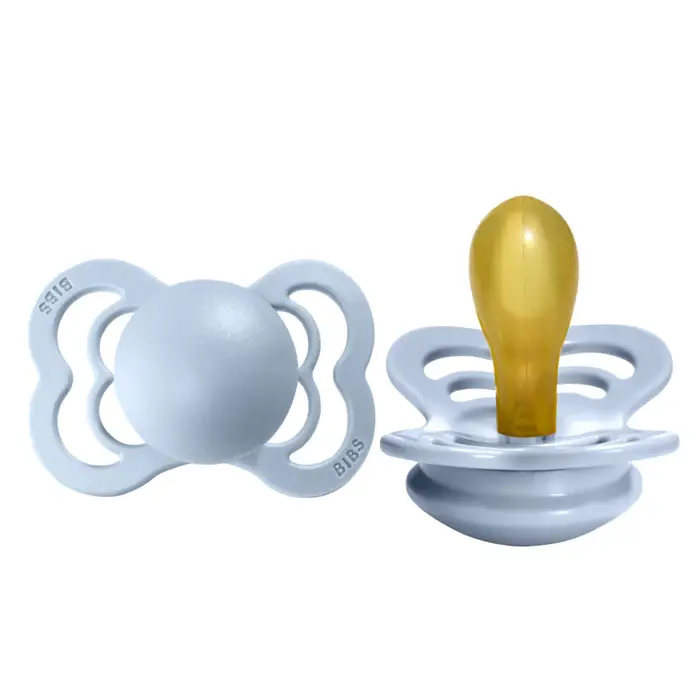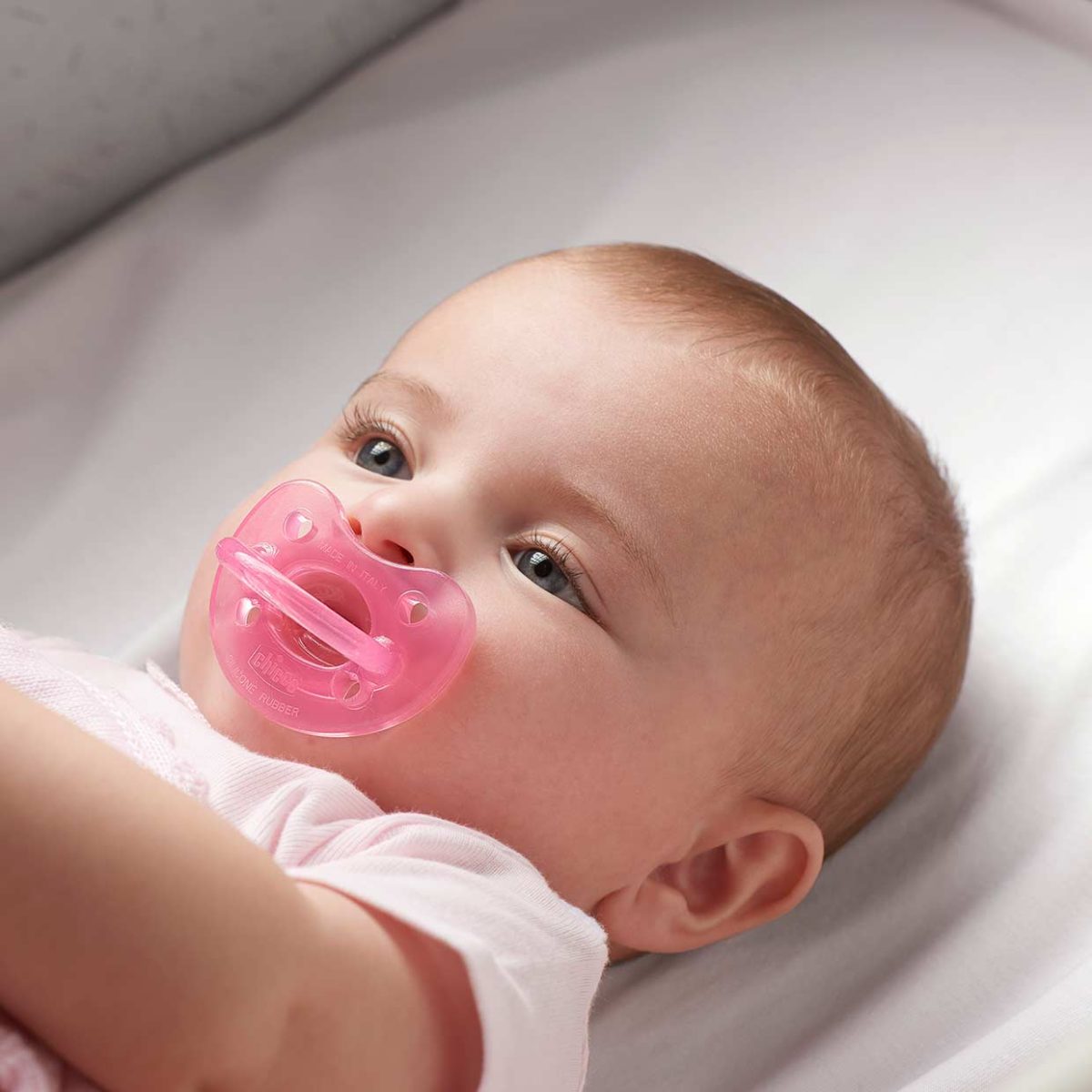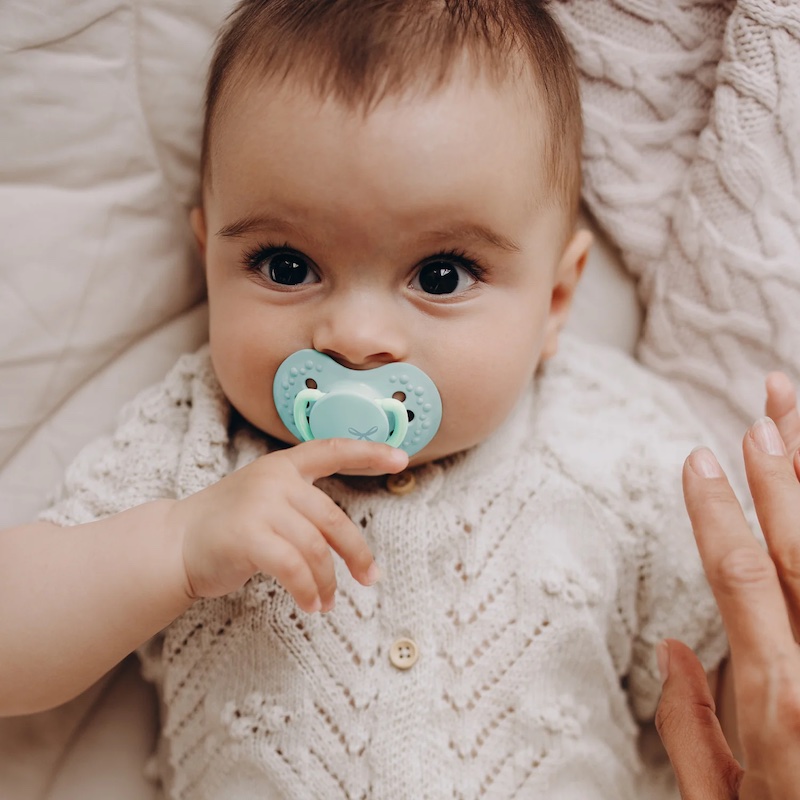Factors to Consider When Choosing a Pacifier
Selecting the right pacifier for your baby involves several important factors that can impact their oral health and development. When searching for dentist-approved pacifiers, these are the considerations you need to keep in mind:
- Material Safety: Look for pacifiers made from safe, non-toxic materials like silicone or natural rubber. They should be free of BPA, PVC, and phthalates to ensure your baby’s safety.
- Pacifier Shape: The shape of the pacifier is crucial. Orthodontic shapes are often recommended because they support natural jaw development. Avoid shapes that might cause dental misalignment.
- Size and Fit: Pacifiers come in various sizes to match different age groups. A properly sized pacifier will fit comfortably in your baby’s mouth without causing strain on the teeth and jaw.
- Shield Design: The shield should be large enough to prevent your baby from choking but have ventilation holes to allow airflow and prevent skin irritation.
- Teat Firmness: The teat should be durable yet soft. A very firm teat may affect tooth positioning, while a too soft one might not satisfy the sucking reflex.
- Ease of Cleaning: Pacifiers need regular cleaning. Choose one that’s easy to sterilize and doesn’t have small parts where bacteria can hide.
- Allergy Considerations: If your child has latex allergies, opt for a silicone pacifier. It’s hypoallergenic and a safer choice.
- Brand Reputation: Research brands with positive reviews and dentist approval. Trusted brands are more likely to follow safety and health guidelines.
By considering these factors, parents can make an informed decision when purchasing a pacifier, thus promoting their baby’s oral health from the outset.
The Impact of Pacifiers on Oral Health
The use of pacifiers has both pros and cons for a baby’s oral health. A correctly designed pacifier can help soothe and calm babies. It may even reduce the risk of sudden infant death syndrome (SIDS). However, long-term use might cause issues with tooth alignment. It’s vital to balance the benefits with the potential risks.
Benefits of Pacifiers on Dental Health
Dentist-approved pacifiers can aid in proper oral development when used correctly. They can encourage the natural positioning of the tongue and jaw. This helps in developing a good bite. They may also prevent the front teeth from protruding by limiting thumb-sucking.
Risks Associated with Pacifier Use
On the other hand, pacifiers can lead to problems if used for too long. They may cause misalignment of the teeth, known as malocclusion. Prolonged use can affect the roof of the mouth. This might lead to a need for orthodontic treatment in the future. It’s important to monitor pacifier use and make changes as needed.
Choosing the right dentist-approved pacifier is essential. Parents should look for one that supports healthy oral development. This helps minimize the risk of any negative impact on a baby’s teeth and jaw.
Dentist-Recommended Pacifier Features
When choosing a pacifier, it is important to look for features that promote oral health and safety. Dentists recommend specific attributes that can help support your baby’s oral development while minimizing potential risks. Here are some key features to consider when selecting a dentist-approved pacifier for your child:
- Orthodontic Design: Opt for a pacifier with an orthodontic design. This supports natural tongue movement and healthy jaw development.
- Non-Toxic Materials: Make sure the pacifier is made from non-toxic materials. Silicone is a good choice as it’s both safe and durable.
- Airflow Vents: Check for a shield with airflow vents. This helps prevent moisture buildup, which can cause skin irritation.
- Appropriate Size: Choose the right size for your baby’s age and mouth structure. This ensures comfort and prevents dental issues.
- Ease of Sterilization: Select a pacifier that’s easy to clean and sterilize. Simple designs without crevices can be best.
- One-Piece Construction: A one-piece pacifier avoids choke hazards. It also tends to be more durable over time.
- BPA-Free: Ensure that the pacifier is BPA-free to avoid exposure to harmful chemicals.
Remember, each baby is different, and what works for one might not work for another. Consider these dentist-approved features alongside your baby’s needs for a suitable choice.
Top Dentist-Approved Pacifier Brands
When it comes to choosing pacifiers that are dentist-approved, brand reputation plays a crucial role. Well-established and renowned brands typically adhere to higher safety and health standards. They often have years of research supporting their product designs. Here’s a list of top pacifier brands that dentists often recommend:
- Philips Avent: Known for their orthodontic pacifiers, Philips Avent designs products that promote natural oral development.
- MAM: This brand offers a range of pacifiers that are developed with pediatric dentists to ensure a healthy mouth development.
- Dr. Brown’s: Dr. Brown’s pacifiers are designed to be similar to their bottle nipples, promoting a consistent sucking pattern.
- Nuk: Nuk’s pacifiers have an asymmetrical shape that mimics the form of a mother’s nipple, which supports proper jaw and teeth alignment.
- Chicco: They provide pacifiers made with soft, flexible silicon that are gentle on gums and teeth, advisable for daily use.
- Tommee Tippee: Their pacifiers are designed to support the natural flex and movement of a baby’s mouth.
Each of these brands offers features that can help you adhere to the factors mentioned previously. These features include orthodontic designs, non-toxic materials, and ease of sterilization. Before making a final decision, make sure to do further research and consider your baby’s specific needs. Remember to look for the dentist-approved mark on the packaging for added assurance.
Choosing the right pacifier is more than just picking a brand; it’s about ensuring the product matches your little one’s developmental stage and health requirements. Always keep safety, comfort, and oral health as your top priorities.
Age-Specific Pacifier Choices
Selecting a pacifier depends largely on your baby’s age. Manufacturers often create pacifiers tailored for specific developmental stages. Each stage considers the growth of the baby’s mouth and jaws. Here are some age-specific options to look for:
- Newborns (0-2 Months): Choose a small, lightweight pacifier. It should suit your newborn’s tiny mouth and not overwhelm their oral cavity.
- Infants (2-6 Months): At this stage, a slightly larger pacifier is needed. It supports a growing baby’s oral needs without being too big.
- Older Infants (6-18 Months): Pacifiers for older infants can be a bit firmer. This helps soothe teething babies and supports healthy oral development.
- Toddlers (18 Months and Up): For toddlers, opt for a robust pacifier. It must withstand more aggressive chewing while promoting proper dental positioning.
It’s key to transition your child to the appropriate pacifier size and shape as they grow. This practice helps maintain good oral health and supports proper teeth alignment. Remember to seek dentist-approved pacifiers that meet the specific needs of your baby’s development stage.
Tips for Introducing a Pacifier to Your Baby
Introducing a pacifier to your baby takes patience and proper technique. Here are some tips for a smooth introduction:
- Wait for the Right Time: Initiate pacifier use after breastfeeding is well established to avoid nipple confusion. This usually means waiting several weeks.
- Let Your Baby Lead: Offer the pacifier when your baby is calm and quiet, not crying or fussy. If they reject it, try again later.
- Avoid Sweetening: Never dip a pacifier in sugar or honey. This can harm your baby’s teeth and may lead to cavities.
- Keep it Clean: Always clean the pacifier before offering it to your baby. Use warm, soapy water and rinse well.
- Introduce Gently: Touch the pacifier to your baby’s cheek to trigger the sucking reflex. Once interested, gently place it in their mouth.
- Pacifier Hygiene: Replace pacifiers regularly and check for wear. Broken or damaged pacifiers can be a safety hazard.
- Security: Have multiples of the same dentist-approved pacifier. This ensures your baby always has one available and feels secure.
- Limit Use: Offer the pacifier primarily for sleep and comfort. Try not to use it as the first line of soothing to prevent over-dependence.
By following these steps and using a dentist-approved pacifier, you can help ensure your baby’s comfort and oral health. Keep in mind that each child is different, and what works for one may not work for another. Stay responsive to your baby’s cues and preferences.
Pacifier Care and Maintenance
Proper care and maintenance of pacifiers are essential to ensure your baby’s health and the longevity of the pacifier. By adhering to these simple steps, you can prevent the growth of bacteria and ensure that your baby’s pacifier remains in good condition:
- Regular Cleaning: Clean the pacifier after each use. Wash it with warm soapy water, rinse thoroughly, and let it air dry.
- Sterilizing: Sterilize the pacifier regularly. For most pacifiers, boiling water or a steam sterilizer will do the job. Check the manufacturer’s instructions for specific guidelines.
- Inspect for Damage: Before giving the pacifier to your baby, inspect it for any wear and tear. Look for cracks, tears, or bite marks that could pose a choking hazard.
- Storage: When not in use, store the pacifier in a clean, dry container. Keep it away from direct sunlight and heat to prevent the material from degrading.
- Avoid Sharing: Never let babies share pacifiers. Sharing can spread germs leading to infections.
- Replacement: Replace the pacifier every two to three months for hygiene and safety reasons, or sooner if you notice any signs of damage.
- Avoid Unnecessary Contact: Don’t ‘clean’ the pacifier by putting it in your mouth. This can transfer bacteria from you to your baby.
Following these care guidelines, along with choosing dentist-approved pacifiers, will help protect your baby’s health and comfort.
When to Wean Your Child Off the Pacifier
Deciding when to wean your child off a pacifier is important for their oral health. Dentist-approved pacifiers can be very helpful in the early stages of a baby’s life. However, extended use can lead to dental problems. Here is a simple guide on when to consider weaning your child off the pacifier:
- Begin Weaning Early: Start considering weaning around the age of 2. This helps prevent dental issues later on.
- Gradual Reduction: Reduce pacifier use slowly. This makes the transition easier for the child.
- Look for Signs: Your child might show readiness to give up the pacifier. These signs could be less frequent seeking or interest.
- Dental Check-Ups: Regular dental check-ups can guide you on when to wean. Your dentist can offer personalized advice.
- Encourage Self-Soothing: Teach other self-soothing techniques. This can make giving up the pacifier less stressful.
Weaning your child off their pacifier should be a gentle process. It is not just about stopping a habit. It’s also about ensuring your child’s comfort during this change. Don’t rush it and stay patient. With time and care, your child can smoothly transition away from the pacifier.




